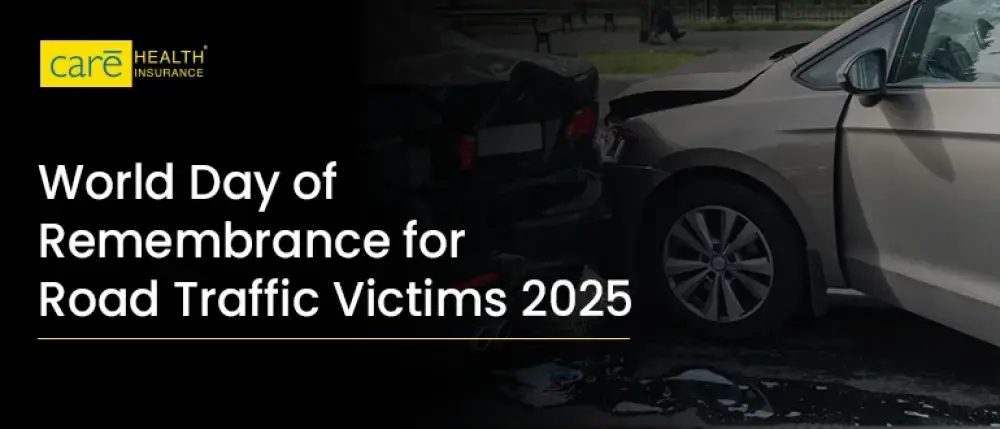Subscribe to get weekly insights
Always stay up to date with our newest articles sent direct to your inbox
Published on 11 Nov, 2025
Updated on 11 Nov, 2025
4 Views
4 min Read

Written by Leena Khowal
Reviewed by Ritika Malik
favorite0Like
favoriteBe the First to Like
Every year, on the third Sunday of November, the world observes the World Day of Remembrance for Road Traffic Victims (WDoR), a day dedicated to honouring those who have lost their lives or suffered injuries in road crashes.
This day, first initiated by RoadPeace (UK) in 1993 and formally adopted by the United Nations in 2005, highlights not only the grief of affected families but also the urgent need for road safety awareness and stronger road traffic accident prevention strategies.
The World Day of Remembrance for Road Traffic Victims 2025, on Sunday, 16 November, encourages every citizen to:
As the UNRSC highlights, remembrance is not only a tribute but a call to collective action toward a world where no one dies or is seriously injured on the road.
Join the movement to honour lives lost and advocate for safer roads. Here’s how you can make a difference this World Day of Remembrance for Traffic Victims 2025:
Road traffic crashes continue to be a global health crisis. According to the World Health Organisation, nearly 1.35 million people die each year as a result of road traffic collisions, making it one of the leading causes of death worldwide, especially among young people aged 5–29 years.
Road safety awareness is not just about following rules; it’s about fostering responsibility, respect, and readiness among road users. Each small action, such as wearing a seat belt, slowing down, and using pedestrian crossings, saves lives.
To improve road traffic accident prevention, it’s essential to identify common causes of road accidents. Research by the World Bank and WHO points to the following key contributors:
Addressing these causes of road accidents through education, enforcement, and engineering is crucial to preventing future tragedies.
In 2023, 7,314 pedestrians were killed, and more than 68,000 pedestrians were injured nationwide.
Pedestrians, cyclists, and motorcyclists account for the majority of road traffic deaths globally. Ensuring pedestrian safety must therefore be a top priority in road safety planning.
Practical steps include:
To prevent road traffic accidents, comprehensive road safety measures require collaboration among individuals, communities, and authorities. Here’s how:
While awareness and prevention are vital, preparedness completes the purpose. Whether you commute daily or embark on a road trip, travel insurance serves as a practical safety net.
A good travel insurance plan can:
In essence, travel insurance embodies the “Support” aspect of the 2025 theme, helping individuals and families recover faster after road-related incidents.
If you travel frequently, check if your policy includes road accident coverage and overseas medical evacuation, as these can make a significant difference when seconds count.
The World Day of Remembrance for Road Traffic Victims is not merely a memorial; it’s a movement. Each year’s theme, especially 2025’s “Remember. Support. Act.”, reminds us to look beyond loss and take responsibility for prevention.
By embracing road safety awareness, enforcing road safety measures, focusing on pedestrian safety, and practising road traffic accident prevention, we turn remembrance into resilience.
As we travel, let’s commit to preparedness because safeguarding life doesn’t end with driving carefully; it extends to protecting ourselves and our loved ones through travel insurance and responsible actions.
Let remembrance guide our steps, and let every safe journey honour the memory of those who never made it home.
Disclaimer: All plan features, benefits, coverage, and claims underwriting are subject to policy terms and conditions. Kindly refer to the brochure, sales prospectus, and policy documents carefully.
favoriteBe the First to Like
List of 10 Countries Where the Indian Rupee is Stronger Care Health Insurance in Travel Insurance Articles
इंडिया से दुबई जाने का खर्चा क्या है? जानें, वीजा से जुड़ी जरूरी बातें Vipul Tiwary in Travel Tips
How to Find File Number in Passport - A Step-by-Step Guide Care Health Insurance in Passport
What Is Non-ECR Category In Passport? How to Apply in 4 Easy Steps? Mudit Handa in Passport
World Heritage Week: Preserving Our Past, Protecting Our Future Pratham Gupta in Travel Awareness Days
World Tsunami Awareness Day 2025: Awareness Can Save Lives Sambriddhi Sharma in Travel Awareness Days
World Cities Day 2025: Shaping the Future of Urban Living Yash in Travel Awareness Days
They can file for compensation under the Motor Vehicles Act through Motor Accident Claims Tribunals (MACT) or seek legal aid via victim support programs.
Training responders in first aid and trauma care, as well as ensuring faster ambulance access, can save more lives.
Survivors may face physical disability, trauma, income loss, and long recovery periods, needing both medical and emotional support.
Dashcams and GPS alerts help detect risks early, enhance driver awareness, and reduce the likelihood of crashes.
Always stay up to date with our newest articles sent direct to your inbox
Loading...